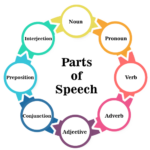Hello, dear students! 🌟
Today, we’re diving into one of the most important topics in English grammar—Tenses. Don’t worry, I’m here to make it as easy as possible for you to understand. By the end of this lesson, you’ll know what tenses are, how to use them, and the differences between each one. Plus, we’ll look at some examples together.
What Are Tenses?
Tenses tell us when an action happens. They help us understand whether something is happening now, happened in the past, or will happen in the future.
The Three Main Tenses
There are three main tenses you need to know:
- Present Tense: Describes actions happening right now or regularly.
- Past Tense: Describes actions that have already happened.
- Future Tense: Describes actions that will happen later.
Each of these tenses can be broken down further, but let’s start with the basics.

1. Present Tense
Definition: The present tense is used for actions that are happening right now or that happen regularly.
How to Use It:
- Simple Present: To talk about habits, facts, and general truths.
- Present Continuous: To talk about actions happening right now.
- Present Perfect: To talk about actions that happened at an unspecified time or have an effect on the present.
- Present Perfect Continuous: To emphasize the duration of an action that started in the past and is still continuing.
Examples:
- Simple Present: She studies every night.
- Present Continuous: He is reading a book now.
- Present Perfect: I have finished my homework.
- Present Perfect Continuous: They have been playing football for an hour.
2. Past Tense
Definition: The past tense is used for actions that have already happened.
How to Use It:
- Simple Past: To talk about completed actions in the past.
- Past Continuous: To talk about actions that were ongoing in the past.
- Past Perfect: To show that an action was completed before another action in the past.
- Past Perfect Continuous: To emphasize the duration of an action that was ongoing before another action in the past.
Examples:
- Simple Past: She studied last night.
- Past Continuous: He was reading a book when I called.
- Past Perfect: I had finished my homework before dinner.
- Past Perfect Continuous: They had been playing football before it started raining.
3. Future Tense
Definition: The future tense is used for actions that will happen later.
How to Use It:
- Simple Future: To talk about actions that will happen.
- Future Continuous: To talk about actions that will be ongoing at a certain time in the future.
- Future Perfect: To show that an action will be completed before a certain time in the future.
- Future Perfect Continuous: To emphasize the duration of an action that will be ongoing until a certain time in the future.
Examples:
- Simple Future: She will study tonight.
- Future Continuous: He will be reading a book at 8 PM.
- Future Perfect: I will have finished my homework by the time you arrive.
- Future Perfect Continuous: They will have been playing football for two hours by 6 PM.
Putting It All Together: A Short Essay Example
Now, let’s see how these tenses can be used in a short essay.
Essay: “My Journey of Learning English”
“I started learning English when I was seven years old (Simple Past). At that time, I didn’t know many words, but I tried my best (Simple Past). Every day, I would read storybooks and watch cartoons in English (Simple Past). Now, I can understand most of what I read and hear (Simple Present). I am improving my speaking skills by practicing with my friends (Present Continuous). By the end of this year, I will have learned a lot more words (Future Perfect). I will be continuing my English studies next year as well (Future Continuous), and I hope to become fluent soon (Simple Present).”
Understanding tenses is essential to speaking and writing correctly in English. Remember, tenses are all about time—whether something is happening now, in the past, or in the future. Practice using these tenses in your sentences, and soon, you’ll find it much easier to express yourself in English.
If you have any questions or need more examples, feel free to ask in the comments! 😊 Happy learning!


